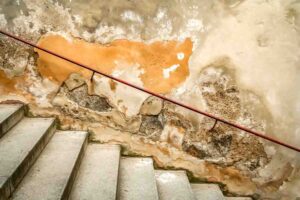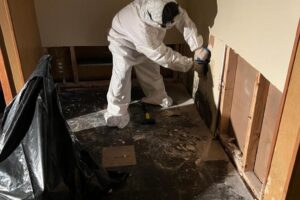Mold growth in homes can be a serious issue, particularly in areas with high humidity or water damage. Understanding when to seek professional mold remediation services is crucial for maintaining a safe and healthy living environment. This article will guide you through the signs that indicate the need for professional intervention, the potential health risks associated with mold exposure, and the steps involved in the remediation process.
Understanding Mold and Its Risks
Mold is a type of fungus that thrives in damp environments. It can grow on various surfaces, including wood, drywall, and carpets. While some mold is harmless, others can produce allergens and irritants that pose health risks.
Health Implications of Mold Exposure
Exposure to mold can lead to a range of health issues, particularly for sensitive individuals. Common symptoms include:
- Respiratory Problems: Mold spores can trigger asthma attacks and other respiratory issues.
- Allergic Reactions: Sneezing, runny nose, and skin rashes are common allergic responses.
- Infections: Individuals with weakened immune systems may be at risk for more severe infections.
Identifying Mold Types
Not all molds are created equal. Some, like black mold (Stachybotrys chartarum), are particularly toxic. Identifying the type of mold present in your home can help determine the urgency of remediation.
Signs You Need Mold Remediation
Recognizing the signs of mold growth is the first step in addressing the problem. Here are some indicators that you may need professional help.
Visible Mold Growth
One of the most obvious signs of mold is its visible presence. Look for:
- Discoloration: Mold can appear as black, green, or white patches on walls, ceilings, and floors.
- Texture Changes: Surfaces may feel fuzzy or slimy.
Musty Odors
A persistent musty smell often indicates mold growth, even if it’s not visible. This odor is caused by the volatile organic compounds (VOCs) released by mold.
Water Damage
If your home has experienced water damage from leaks, flooding, or high humidity, it’s essential to check for mold. Areas to inspect include:
- Basements: Often damp and prone to mold growth.
- Crawl Spaces: These areas can trap moisture and harbor mold.
Health Symptoms
If you or your family members experience unexplained health issues, it may be time to consider mold remediation. Symptoms to watch for include:
- Chronic Coughing: Persistent coughs that worsen indoors.
- Fatigue: Unexplained tiredness that doesn’t improve with rest.
The Importance of Professional Mold Remediation
While DIY methods may seem appealing, professional mold remediation is often necessary for effective and safe removal.
Expertise and Equipment
Professionals have the training and tools to identify and eliminate mold effectively. They use advanced techniques such as:
- Moisture Mapping: Identifying hidden moisture sources.
- Air Quality Testing: Assessing the presence of mold spores in the air.
Safety Considerations
Mold remediation can be hazardous, especially if toxic molds are present. Professionals follow safety protocols to protect themselves and your family, including:
- Personal Protective Equipment (PPE): Wearing masks, gloves, and suits to prevent exposure.
- Containment Procedures: Preventing mold spores from spreading during the remediation process.
The Mold Remediation Process
Understanding the steps involved in mold remediation can help you feel more prepared for the process.
Initial Inspection
The first step is a thorough inspection of your property. Professionals will:
- Assess the Extent of the Problem: Identify affected areas and the type of mold present.
- Determine Moisture Sources: Find out where the moisture is coming from to prevent future growth.
Containment
To prevent mold spores from spreading, professionals will set up containment barriers. This may involve:
- Sealing Off Affected Areas: Using plastic sheeting to isolate the work area.
- Negative Air Pressure: Using fans to direct air out of the containment area.
Removal and Cleanup
Once containment is established, the remediation team will begin the removal process. This includes:
- Removing Contaminated Materials: Safely disposing of mold-infested items such as drywall or insulation.
- Cleaning Surfaces: Using specialized cleaning agents to disinfect affected areas.
Drying and Dehumidification
After removal, it’s crucial to dry the area thoroughly to prevent mold from returning. This may involve:
- Industrial Fans: Using high-powered fans to circulate air.
- Dehumidifiers: Reducing humidity levels to inhibit mold growth.
Post-Remediation Testing
Once the remediation process is complete, professionals will conduct testing to ensure that mold levels are safe. This includes:
- Air Quality Testing: Checking for remaining mold spores in the air.
- Surface Testing: Ensuring that all surfaces are free from mold.
Preventing Future Mold Growth
After remediation, taking steps to prevent mold from returning is essential.
Control Humidity Levels
Keeping humidity levels below 60% can significantly reduce the risk of mold growth. Consider:
- Using Dehumidifiers: Especially in damp areas like basements.
- Ventilating Bathrooms and Kitchens: Ensuring proper airflow to reduce moisture.
Regular Inspections
Conducting regular inspections of your home can help catch mold growth early. Look for:
- Signs of Water Damage: Check for leaks or damp spots.
- Visible Mold: Regularly inspect areas prone to moisture.
Maintenance of HVAC Systems
Your HVAC system can be a breeding ground for mold if not properly maintained. Ensure:
- Regular Cleaning: Have your HVAC system cleaned and inspected regularly.
- Filter Changes: Change filters every few months to improve air quality.
When to Call a Professional
Knowing when to call in the experts can save you time, money, and health risks. Consider reaching out for professional mold remediation if you notice:
- Extensive Mold Growth: If mold covers more than 10 square feet, it’s best to consult professionals.
- Persistent Health Issues: If symptoms persist despite cleaning efforts, professional help is warranted.
- Water Damage: After significant water damage, a professional assessment is crucial.
Conclusion
Mold can pose serious health risks and damage to your home if left unchecked. Recognizing the signs of mold growth and understanding when to seek professional remediation services is vital for maintaining a safe living environment. By taking proactive measures and addressing mold issues promptly, you can protect your home and your health.
For more information about Mold Remediation in Elizabeth New Jersey please contact:
Business Name: Green Guard Mold Specialist Elizabeth
Address: 919 S Elmora Ave, Elizabeth, NJ 07202
Phone Number: 888-861-7846
Website: https://www.greenguardmoldelizabeth.com/
Google Map: https://maps.app.goo.gl/sBzFpCgjU9bd8sibA


